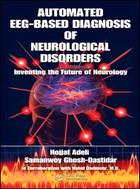Automated EEG-Based Diagnosis of Neurological Disorders: Inventing the Future of Neurology
商品資訊
ISBN13:9781439815311
出版社:CRC Press UK
作者:Hojjat Adeli; Samanway Ghosh-dastidar; Nahid Dadmehr M.D. (CON)
出版日:2010/02/09
裝訂/頁數:精裝/423頁
定價
:NT$ 13650 元優惠價
:90 折 12285 元
若需訂購本書,請電洽客服 02-25006600[分機130、131]。
商品簡介
作者簡介
目次
商品簡介
Based on the authors’ groundbreaking research, Automated EEG-Based Diagnosis of Neurological Disorders: Inventing the Future of Neurology presents a research ideology, a novel multi-paradigm methodology, and advanced computational models for the automated EEG-based diagnosis of neurological disorders. It is based on the ingenious integration of three different computing technologies and problem-solving paradigms: neural networks, wavelets, and chaos theory. The book also includes three introductory chapters that familiarize readers with these three distinct paradigms.
After extensive research and the discovery of relevant mathematical markers, the authors present a methodology for epilepsy diagnosis and seizure detection that offers an exceptional accuracy rate of 96 percent. They examine technology that has the potential to impact and transform neurology practice in a significant way. They also include some preliminary results towards EEG-based diagnosis of Alzheimer’s disease.
The methodology presented in the book is especially versatile and can be adapted and applied for the diagnosis of other brain disorders. The senior author is currently extending the new technology to diagnosis of ADHD and autism. A second contribution made by the book is its presentation and advancement of Spiking Neural Networks as the seminal foundation of a more realistic and plausible third generation neural network.
After extensive research and the discovery of relevant mathematical markers, the authors present a methodology for epilepsy diagnosis and seizure detection that offers an exceptional accuracy rate of 96 percent. They examine technology that has the potential to impact and transform neurology practice in a significant way. They also include some preliminary results towards EEG-based diagnosis of Alzheimer’s disease.
The methodology presented in the book is especially versatile and can be adapted and applied for the diagnosis of other brain disorders. The senior author is currently extending the new technology to diagnosis of ADHD and autism. A second contribution made by the book is its presentation and advancement of Spiking Neural Networks as the seminal foundation of a more realistic and plausible third generation neural network.
作者簡介
Hojjat Adeli is the Abba G. Lichtenstein Professor at The Ohio State University, Editor-in-Chief of the International Journal of Neural Systems, and author of 14 pioneering books. Samanwoy Ghosh-Dastidar is Principal Biomedical Engineer at ANSAR Medical Technologies in Philadelphia. Nahid Dadmehr is a board-certified neurologist in practice in Ohio since 1991.
目次
Basic Concepts Introduction
Time-Frequency Analysis: Wavelet Transforms Signal Digitization and Sampling Time and Frequency Domain Analyses Time-Frequency AnalysisTypes of Wavelets Advantages of the Wavelet Transform
Chaos Theory Introduction Attractors in Chaotic SystemsChaos
Classifier Designs Data Classification Cluster Analysis k-Means Clustering Discriminant Analysis Principal Component Artificial Neural Networks
Automated EEG-Based Diagnosis of Epilepsy Electroencephalograms and Epilepsy Spatio-Temporal Activity in the Human EEG: A Spatio-Temporal Data Data Mining Techniques Multi-Paradigm Data Mining Strategy for EEGsEpilepsy and Epileptic Seizures
Analysis of EEGs in an Epileptic Patient Using Wavelet Transform Introduction Wavelet Analysis of a Normal Characterization of the 3-Hz Spike and Slow Wave Complex inAbsence Seizures Using Wavelet Concluding Remarks
Wavelet-Chaos Methodology for Analysis of EEGs and EEG Sub-Bands IntroductionWavelet-Chaos Analysis of EEG Application and Results Concluding Remarks
Mixed-Band Wavelet-Chaos Neural Network Methodology Introduction Wavelet-Chaos Analysis: EEG Sub-Bands and Feature Space Design Data Analysis Band-Specific Analysis: Selecting Classifiers and Feature Mixed-Band Analysis: Wavelet-Chaos-Neural Network Concluding Remarks
Principal Component Analysis-Enhanced Cosine Radial Basis Function Neural Network Introduction Principal Component Analysis for Feature Cosine Radial Basis Function Neural Network: EEG ClassificationApplications and Results Concluding Remarks and Clinical Significance
Automated EEG-Based Diagnosis of Alzheimer’s Disease Alzheimer’s Disease and Models of Computation: Imaging, Classification, and Neural Models Introduction Neurological Markers of Alzheimer’s Imaging Studies Classification Models . Neural Models of Memory and Alzheimer’s Disease Approaches to Neural Modeling
Alzheimer’s Disease: Models of Computation and Analysis of EEGs EEGs for Diagnosis and Detection of Alzheimer’s Disease Time-Frequency Analysis Wavelet Analysis Chaos Analysis Concluding Remarks
A Spatio-Temporal Wavelet-Chaos Methodology for EEG Based Diagnosis of Alzheimer’s Disease IntroductionMethodology Description of the EEG Results Complexity and Chaoticity of the EEG: Results of theThree-Way Factorial ANOVA Discussion Concluding Remarks
Third Generation Neural Networks: Spiking Neural Networks Spiking Neural Networks: Spiking Neurons and Learning Algorithms Introduction Information Encoding and Evolution of Spiking Mechanism of Spike Generation in Biological Neurons Models of Spiking Neurons Spiking Neural Networks (SNNs) Unsupervised Learning Supervised Learning
Improved Spiking Neural Networks with Application to EEG Classification and Epilepsy and Seizure Detection XOR Classification Problem Fisher Iris Classification Problem EEG Classification Problem Input and Output Encoding Concluding Remarks
A New Supervised Learning Algorithm for Multiple Spiking Neural Networks Introduction Multi-Spiking Neural Network (MuSpiNN) and Neuron Model Multi-SpikeProp: Backpropagation Learning Algorithm for MuSpiNN
Applications of Multiple Spiking Neural Networks: EEG Classification and Epilepsy and Seizure Detection Parameter Selection and Weight Initialization Heuristic Rules for Multi-SpikeProp XOR Problem Fisher Iris Classification Problem EEG Classification Problem Discussion and Concluding Remarks
The Future
Bibliography
Index
Time-Frequency Analysis: Wavelet Transforms Signal Digitization and Sampling Time and Frequency Domain Analyses Time-Frequency AnalysisTypes of Wavelets Advantages of the Wavelet Transform
Chaos Theory Introduction Attractors in Chaotic SystemsChaos
Classifier Designs Data Classification Cluster Analysis k-Means Clustering Discriminant Analysis Principal Component Artificial Neural Networks
Automated EEG-Based Diagnosis of Epilepsy Electroencephalograms and Epilepsy Spatio-Temporal Activity in the Human EEG: A Spatio-Temporal Data Data Mining Techniques Multi-Paradigm Data Mining Strategy for EEGsEpilepsy and Epileptic Seizures
Analysis of EEGs in an Epileptic Patient Using Wavelet Transform Introduction Wavelet Analysis of a Normal Characterization of the 3-Hz Spike and Slow Wave Complex inAbsence Seizures Using Wavelet Concluding Remarks
Wavelet-Chaos Methodology for Analysis of EEGs and EEG Sub-Bands IntroductionWavelet-Chaos Analysis of EEG Application and Results Concluding Remarks
Mixed-Band Wavelet-Chaos Neural Network Methodology Introduction Wavelet-Chaos Analysis: EEG Sub-Bands and Feature Space Design Data Analysis Band-Specific Analysis: Selecting Classifiers and Feature Mixed-Band Analysis: Wavelet-Chaos-Neural Network Concluding Remarks
Principal Component Analysis-Enhanced Cosine Radial Basis Function Neural Network Introduction Principal Component Analysis for Feature Cosine Radial Basis Function Neural Network: EEG ClassificationApplications and Results Concluding Remarks and Clinical Significance
Automated EEG-Based Diagnosis of Alzheimer’s Disease Alzheimer’s Disease and Models of Computation: Imaging, Classification, and Neural Models Introduction Neurological Markers of Alzheimer’s Imaging Studies Classification Models . Neural Models of Memory and Alzheimer’s Disease Approaches to Neural Modeling
Alzheimer’s Disease: Models of Computation and Analysis of EEGs EEGs for Diagnosis and Detection of Alzheimer’s Disease Time-Frequency Analysis Wavelet Analysis Chaos Analysis Concluding Remarks
A Spatio-Temporal Wavelet-Chaos Methodology for EEG Based Diagnosis of Alzheimer’s Disease IntroductionMethodology Description of the EEG Results Complexity and Chaoticity of the EEG: Results of theThree-Way Factorial ANOVA Discussion Concluding Remarks
Third Generation Neural Networks: Spiking Neural Networks Spiking Neural Networks: Spiking Neurons and Learning Algorithms Introduction Information Encoding and Evolution of Spiking Mechanism of Spike Generation in Biological Neurons Models of Spiking Neurons Spiking Neural Networks (SNNs) Unsupervised Learning Supervised Learning
Improved Spiking Neural Networks with Application to EEG Classification and Epilepsy and Seizure Detection XOR Classification Problem Fisher Iris Classification Problem EEG Classification Problem Input and Output Encoding Concluding Remarks
A New Supervised Learning Algorithm for Multiple Spiking Neural Networks Introduction Multi-Spiking Neural Network (MuSpiNN) and Neuron Model Multi-SpikeProp: Backpropagation Learning Algorithm for MuSpiNN
Applications of Multiple Spiking Neural Networks: EEG Classification and Epilepsy and Seizure Detection Parameter Selection and Weight Initialization Heuristic Rules for Multi-SpikeProp XOR Problem Fisher Iris Classification Problem EEG Classification Problem Discussion and Concluding Remarks
The Future
Bibliography
Index
主題書展
更多
主題書展
更多書展今日66折
您曾經瀏覽過的商品
購物須知
外文書商品之書封,為出版社提供之樣本。實際出貨商品,以出版社所提供之現有版本為主。部份書籍,因出版社供應狀況特殊,匯率將依實際狀況做調整。
無庫存之商品,在您完成訂單程序之後,將以空運的方式為你下單調貨。為了縮短等待的時間,建議您將外文書與其他商品分開下單,以獲得最快的取貨速度,平均調貨時間為1~2個月。
為了保護您的權益,「三民網路書店」提供會員七日商品鑑賞期(收到商品為起始日)。
若要辦理退貨,請在商品鑑賞期內寄回,且商品必須是全新狀態與完整包裝(商品、附件、發票、隨貨贈品等)否則恕不接受退貨。































